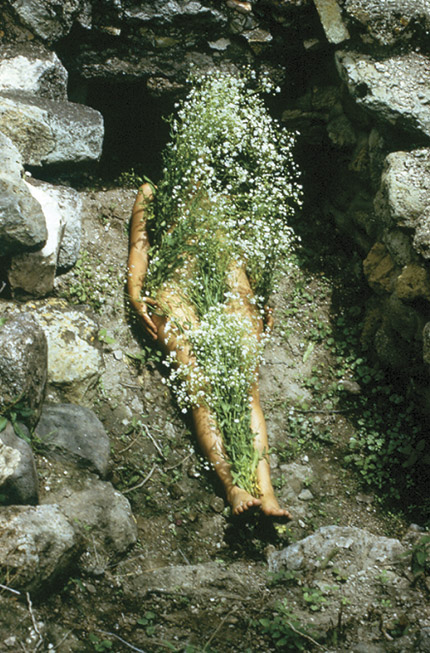If ever there were a place where the body of Cuban-born American artist Ana Mendieta is hauntingly absent, it is in the Art Institute of Chicago’s current exhibition. The presence of these important images, some of which are representations of the artist’s body, are reminders that much of the content of Mendieta’s often-ephemeral practice occurred elsewhere and will never occur in the gallery because of her early, violent death.
The videos, photo documentations and sculptures by Mendieta are on display in their entirety until January 15. Using her body and the female form in combination with natural environments and materials, Mendieta addressed issues of place, physical presence and existence grounded in nature, often with spiritual undertones. The work points to the corporal presence and symbolic absence of women in society and in art.
Mendieta was an influential body and land artist in the 1970s and ‘80s and is a foundational figure for much feminist art that has been produced since. Although certain uses of the female body in art have been challenged by critics of essentialist thought — the inclination to denote the feminine with nature — Mendieta’s practice maintains relevance through its bold imagery and sincerity.

“Untitled, Blood Sign #1” is a video documentation of Mendieta tracing the outline of her body with animal blood on a whitewashed wall. Facing the wall, her back to the camera, Mendieta dips her open palms into a cask of blood and presses them to the unsoiled surface. Dragging them down along the sides of her otherwise stationary body, Mendieta makes a mark and simultaneously marks herself on the surface. The double imposition is the crux of much early feminist work — to represent and be represented. The act of inscription ends with the artist crudely printing “There is a Devil inside me” within the bloody outline.
The show also includes photographs from Mendieta’s most well known series “Silueta.” The series relies on traces of the female body sometimes the artist’s, sometimes a crude outline made from various natural materials. The images are documents of performances in which Mendieta would interact with elements of a particular landscape such as dirt, wildflowers and branches. At times the resulting formations are additive (piling sand) sometimes they are subtractive (digging a hole), but they are never permanent.
It is frustrating that discussions of Mendieta’s work almost always contain a reference to her death in 1985 from a fall out of a 34th floor window. The minimalist sculptor Carl Andre, her husband at the time, was subsequently charged with murder and acquitted. Ideally an artist’s work should communicate beyond biographic information. One reason the story and the work seem inseparable is that Mendieta’s death robs us of the ability to experience her work other than through documentation. Another is that her work and death share so many themes: violence acted out on the female body and tragically, its ultimate absence.







